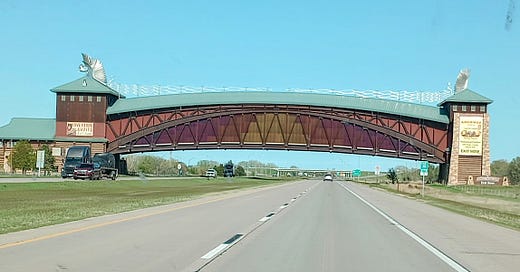The Museum on the Freeway. Literally.
ANNETTE ON THE ROAD A fabulous location for a fabulous museum about people on the move across America, PLUS bonus for paid readers on taking kids to the museum

This is an Annette on the Road post at Non-Boring History. Renegade history professor/Brit in the US Dr. Annette Laing takes you to museums and historic sites all over the US and UK, Canada, and beyond. Why? Because they’re there! Ok, maybe there’s more to it.
Become a Nonnie (paying reader, partnering with me) for as little as $5 a month, and get to feel very smug my readalouds in my cool mostly British accent on most posts, get the chance to get occasional actual mail from me, join the community in comments and in person via Zoom or when I hold a coffee near you (can happen!) And learn things you never knew you never knew, including why they matter.
Note from Annette
Best. Location. Ever.
I promised you we would try to get here during opening hours! AND WE DID! Hoosen, my long-suffering spouse, and I finally made it (see photo above) in May. It was Hoosen who realized that, on yet another journey of thousands of miles across America, we might finally just time our arrival in this remote part of remote Nebraska in time to visit this museum, and we did! Excitement City!
Honestly, I was all set to confirm my suspicions that this museum is probably just a pricy el crappo tourist trap, but I HAVE CHANGED MY MIND! It’s good!
Now, I don’t know whether I wish this on you or not, but maybe one day, you too will drive across America on the I-80 freeway. Okay, most likely you won’t, but I nonetheless think it only fair to say that this post is full of spoilers.
First off, the Great Platte River Road Archway Monument is a bloody awful name for a museum. It’s too long. It doesn’t tell you what this is. And it doesn’t make anyone want to stop. Good news! The museum’s name has been changed to The Archway! Much better.
What does make someone stop at The Archway?
Seriously? I mean, look at it! A big ass arch spanning the freeway, sprouting tacky posters and giant eagle statue thingies, like it was designed by American showman Buffalo Bill Cody while drunk. A coincidence? I think not, considering he lived not too far from here, yeah, okay, a hundred miles away, but that’s practically next door on the Great Plains.
As to the Archway’s promise, I think it more than delivers on its exterior. It also surprises.
Laing, it must be surprising. Because I have no clue from the photo what that’s about.
Ooh, good point! Okay, this museum is right outside Kearney, Nebraska, in the Platte River Valley. The I-80 is a major artery across the US, and it very roughly follows the route wagon migrants took across mid-19th century America. So the museum is about Westward migration, but, it turns out, it’s about even more than the 19th century wagons. And I don’t mean it’s full of irrelevant crap.
Museums as Theme Parks
Full Confession: I’m a recovering Disneyland/Disney World fan. Recovering? Oh, yeah. When Hoosen and I lived in Southern California, even though I was in grad school on the outskirts of Los Angeles, Disneyland was a wonderful break, and I occasionally talked Hoosen into a visit. But about a decade ago, Hoosen, Hoosen, Jr., and I all realized in the same moment that we were all done with the various Disney theme parks. Good call, because in the years since, thanks to the UGs (Usual Grifters) visiting Disney theme parks has become absurdly expensive, and seems to have morphed into a nightmare of digital overplanning, where you have to keep your phone in your hand the whole time. Bleagh.
But I’m still wistful that I may never again darken the doors of the House of Mouse. That’s why I love big spectacular historical displays where you get a feeling of being there. I love a fun exhibit of quality life-size mannikins posed against a historically-believable background, especially when outside, is the real place. Remember our visit to the Cyclorama and its wild history in Atlanta?
So, yeah, The Archway delivers on that.
Don’t Mess With the West
The Westward journey of wagons to California (and Oregon, and Salt Lake City) loans itself to the big tableau treatment in museums, and why would we be surprised? The far West is full of epic panoramic landscapes in which every last one of us visitors feels that awe of “oh, I’m an ant! A squashable ant!
Those stunning Western landscapes can also severely punish hubris, human pride and arrogance, and by severely, I’m talking corporal and even capital punishment.
Think you can dance for a TikTok video on the very edge of the Grand Canyon? Think again, or you may never think again.
Think you can pet a buffalo? Nope, and, if you do, you may end up with a very sore bottom, or dead.
Think you can go for a drive through Death Valley in summer with only a mega-sized Coca-Cola to drink? Uh-uh. Dehydration is real, and it doesn’t care about your feelings,
Think it’s wise to ignore the advice of a National Park Service ranger because she’s only some nerd in a silly outfit? I very strongly advise you get some respect, which is waaaaay better than regret, especially when that same ranger ends the day helping haul your sorry arse out of some canyon, ok?
Crossing the West was a humbling experience for the 19th century covered wagon people, a lesson they called “seeing the elephant” (interesting metaphor of uncertain origin that we’ll be touching upon in another post). “Seeing the elephant” was a lesson that those who survived the journey never forgot.
The more advanced our transportation became, as wagons gave way to stagecoaches, as stagecoaches bowed to trains, as trains were abandoned for Model Ts, as Model Ts became big Chevys, and then SUVs full of people with smartphones, AND as trails became paved roads, and then freeways with McDonalds and Starbucks and ridiculously large gas stations that doubled as mega-marts, the more convinced we became that we had mastered that Western landscape.
Uh huh. Tell that to the people who were stranded for 24 hours recently on the freeway between LA and Vegas.
So you say you want to ditch the freeways for the “real” roads of the West, eh? You plan to rely on GPS to drive through Nevada or Wyoming off the beaten path? Nope. That was the sharp warning the historian and her engineer husband got when they realized they were lost on dirt roads, with no cell signal, although thankfully (thanks truly to the engineer husband) we had a full tank and plenty of water in the back. We were fine (obviously) but it was chastening. Ever since then, I’ve told people: Don’t mess with the West. She is a stern mother.
Uh-huh, Uh-huh, Stayin’ Alive: Immersive Museums
Stick to the I-80 freeway, carry your phone, and lots of water and emergency snacks and all that, and you will (almost certainly) be fine. But you will also miss out on something delicious that even the smallest risk of getting off the freeway corridor delivers.
However, there are ways to enjoy that sense of danger, without risking it. And that’s by traveling with travelers past, including the wagon folk, who, although not as free as Hollywood would have us believe, at least didn’t have to deal with barbed wire.
So how to experience? Read about diaries and histories. Check out my sloooowly rolling out West With the Wagons series. For adventurous types, follow the wagon trails with the help of the US Park Service (Do take their advice very seriously, so you don’t end up a desiccated corpse in the desert, as my mother-in-law is convinced that Hoosen and I will one day.)
Or just see what you can from the freeway on a Great American Road Trip. Whether or not The Archway museum (and yes, I’m going to talk about it!) works out for your plans, I can certainly recommend other excellent museums for an immersive experience.
There are two museums in particular that I have visited (a third is in Oregon) that are even better than The Archway, and they include lots of lovely simulated scenes of the wagon journey West. Both of them are projects of the federal government, and both are free to enter.*
*Conservative friends, I submit to you that Keynesian economics, a mixed economy, works. These museums by the Department of the Interior’s Bureau of Land Management are great examples of small investment paying huge dividends in education and heritage tourism. Supply side economics, the Friedrich Hayek/Milton Friedman school adopted by Margaret Thatcher and Ronald Reagan, how’s that working out? Serious question. Do tell.
I’m thinking The National Historic Trails Interpretive Center in Casper, Wyoming, off the I-25 and the smaller but superb California Trail Interpretive Center near Elko, Nevada, off the I-80. Hoosen and have I visited them both (and we’ve visited the Elko one several times) and big thumbs up.
ANNETTE’S ASIDE It was interesting to meet a very pleasant conservative staffer at the California Trail Interpretive Center a couple of years ago who thought government spending should be massively cut. He was like a real-life Ron Swanson from the sitcom Parks and Rec. I was kind and didn’t pick a fight, but I should have asked this intelligent man whether he was an unprincipled grifter, an idiot, or both? Now don’t cancel me, conservative friends. Among my great heroes is the UK Conservative former MP Lord James Arbuthnot, a highly-principled man with whom I have irreconcilable political differences, but whom I would follow to the ends of the Earth, and trust with my life. But this chap in Nevada, working for the same government he despises? Shame on him for not picking to change either his job or his views. Or maybe it’s not that simple. I’m curious about his defense. But I digress.
Why the Archway?
Since those other two museums I mentioned are free, why even bother with the Archway museum, when you have to pay to get in? Several possible reasons:
You’re on a dedicated Follow the Wagons trip across the Platte Valley, and are keen to hit all the places! In that case, YES! This is very close to Fort Kearny [sic], so you can hit them both on the same day if you stay in the city of Kearney, Nebraska, at least one night. Loads of hotels and restaurants, friendly folk, do give Kearney my love.
Blimey, you say, you’re not going all the way to Wyoming, much less Nevada. But your sister lives in Denver, you live in Chicago, and this makes a good destination to break up a road trip (with or without the kids/grandchildren and/or grandpa, who uses a wheelchair.) Yes!
It’s worth your while
Without further ado, let’s check out The Archway! I mean, how big can it be? Seriously. Shouldn’t take long, I thought, looking at it from the freeway, and from the parking lot. I guess we just walk from one end to the other, and then back again? I forgot one of my own sayings: The West mucks up your sense of size, of space.
Rising to the Occasion
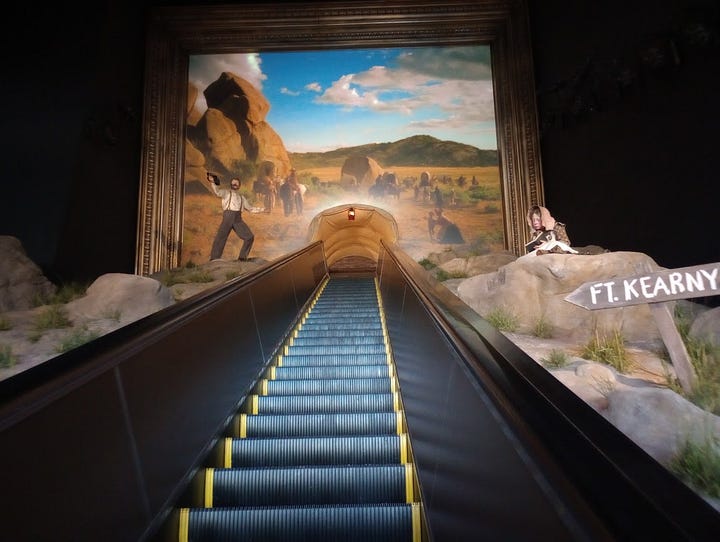
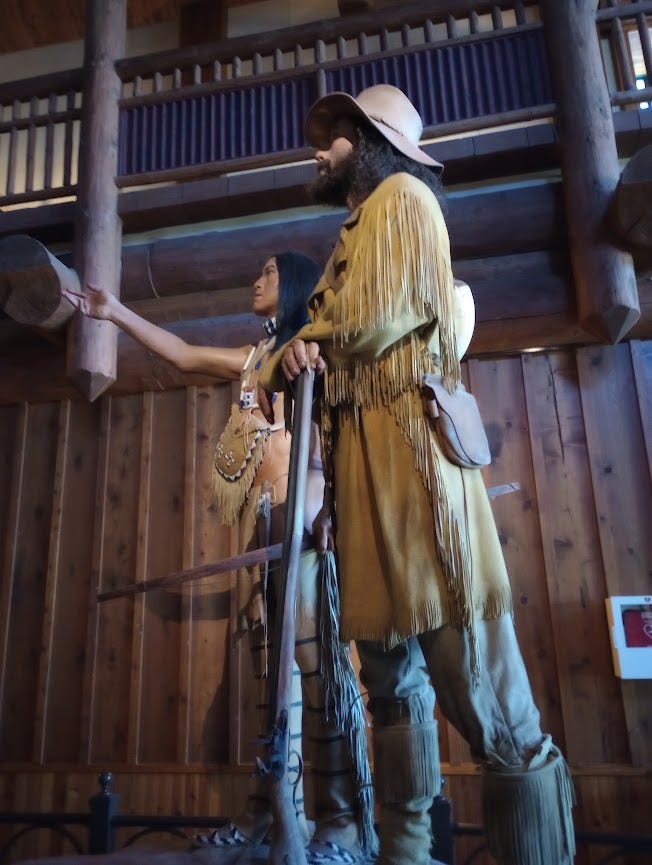
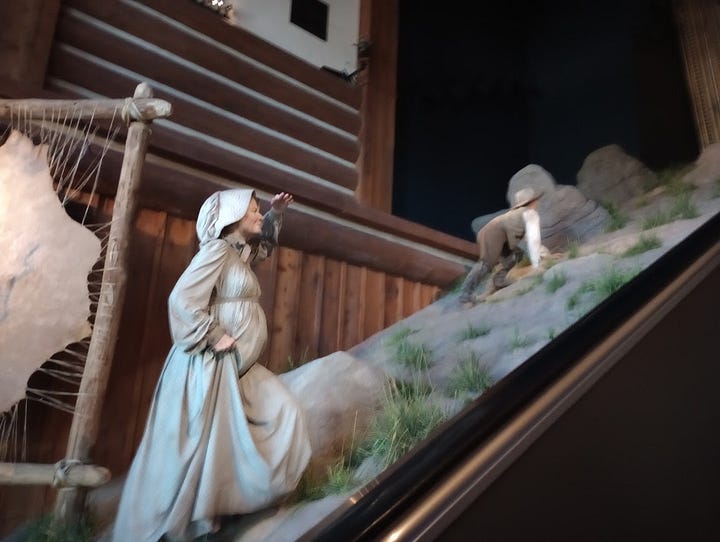

And the award for most creative presentation of an escalator goes to . . . The Archway!
After buying our tickets in the gift shop, we were directed to the friendly staffer who greeted us at the foot of the exciting escalator. She handed us each headsets for the free self-guided audio tour, and told us how to use them. Note that there are also info panels throughout the museum, but I always recommend at least trying audio tours for adults, especially when they’re free of charge or cheap.

This is a pretty good audio tour. But if this or any audio tour turns out not to be your thing, you can just stop using it. Or just skip bits. I know museum visitors often feel a need to look clever (read museum reviews on Google to see what I mean) but please don’t persist with something that’s not working for you. Nobody except a twit will judge you. This and most audio tours are easy to use: You just tap in a number you see on the displays, and off you go. This tour’s narration includes actors voicing the words of migrant diaries, so that’s cool. Except it was painful to hear a British character being voiced by an actor with a Midwestern US accent Seriously? C’mon. You couldn’t find a British voice actor or a reasonable imitator? Please. Okay, yes, this exhibit was built back in the 90s. I get it.
This isn’t a thrilling description on my part, but this first section of the museum is two big rooms on the Westward wagon trails, an immersive 3D sort of experience. You can just walk through it quickly without reading info panels or listening to the audio tour, but that misses out most of what it has to offer, and that’s silly. I have no patience for snippy online reviews from people who clearly didn’t take advantage of any of the interpretive resources here. Unless you are . . .
Visiting The Archway with Children: See Bonus for Nonnies (paying subscribers only) at end of post
Entering the Fort in 1849

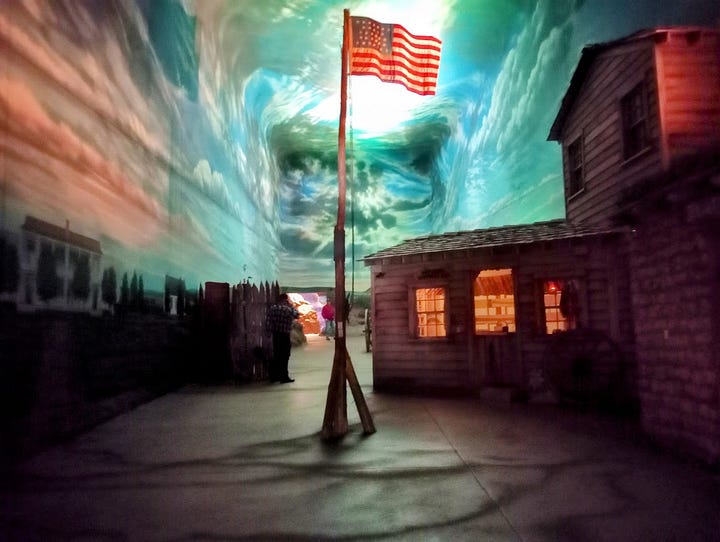
Hoosen and I have visited nearby Fort Kearny State Park a couple of times, and it really doesn’t look much like this interpretation at The Archway and never did, but who cares? This little riff on the fort has great atmosphere, just like Disney’s Tom Sawyer Island, and that counts a lot. The real Fort Kearny was a major stop on the wagon trail, and it supplied food, postal services, a wagon repair shop, and more. I wrote about it here:
By now, whether you’re with kids or not, everyone is fascinated by that swirling moving projection of a sky in this room. The sky cycles through times of day and various weather types, including a storm with thunder and lightning.
I’m sorry, but all my photos suck a bit: The museum went with atmospheric lighting, which isn’t always good for my amateur photography. But you’ll get the idea, I hope. Without kids? Read info panels, listen to the audio tour. With kids? Point out how hard it would be to walk across the prairies (yes, most people walked!) with the crummy weather.
Anyhow, that’s enough touring advice. Don’t forget to mouse over each image to see it.

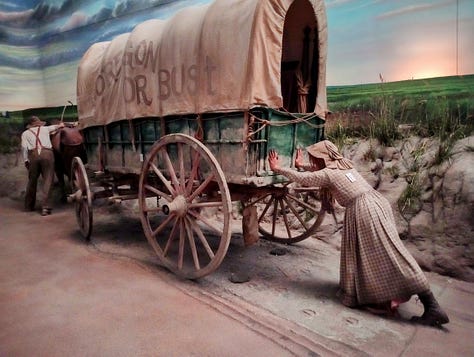

In the end, I didn’t listen to all the audio, or read every word on the info panels because, while it was all engaging, there was a lot to it, and I know a fair bit about the subject these days (No, I haven’t forgotten my West With the Wagons series, just the usual issue of finding time when I’m putting in 6.5 days a week minimum working! Not giving up!) And if you’re on the road, you may not have much time: Hoosen and I showed up just two hours before The Archway closed. But do read/listen to what you can, since the museum is meant to be enjoyed in this way.
I loved seeing the lifesize depiction of a couple struggling to get the wagon to Chimney Rock, a real landmark for the Westward journey, which is farther west in Nebraska (well off the I-80, but worth considering as a detour, along with Scotts Bluff). And just look at that middle-class Victorian lady who has no choice but to push the damn wagon if they’re gonna make it to all the way to Oregon! Oh, Western women, I salute you! Nobody’s calling you a Karen and getting away with it.
But wait. What about talking about the Native peoples of this land? Yes, this exhibit could have been better on that score, but it was done in the 1990s, and it’s not bad. Some wokey (and almost certainly white) ninny left a one-word online review (“Racist”) and that’s a judgment that’s neither true nor fair, and I hope doesn’t stop even a single visitor from checking it out. Easy and lazy judgments are the prerogative of youth, and old battleaxes like me telling them off is a prerogative of age.
Oh, old people don’t matter, huh? Wait, I thought you respected American Indian cultures? You do? Okay, go air your fascinating views about the irrelevance of elders at a tribal pow wow, and watch people politely but pointedly move away from you . . .
Look, the museum is now about thirty years old, built when inclusion was just getting started in the 90s, and there’s never much money for improvements in the world of museums. A mannikin of a Native woman is practically the first image that greets you at the escalator. And later exhibits do a fair, even very good job of representation. Plus most migrants were white, and only recently, with the work of my learned colleague Dr. Shirley Ann Wilson Moore, have we learned much more about the Black migrants who went West with the wagons.
A Tough Journey plus cool buffalo


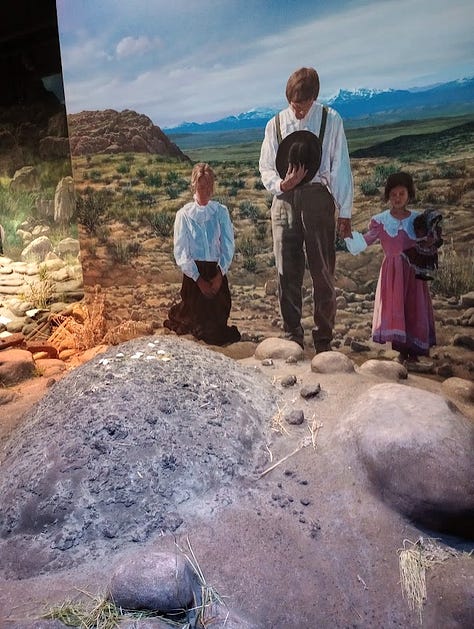
More atmosphere in the second room, in the form of fake rocks, and scenes of the boredom and hardship of the journey. We see men cooking and writing around a campfire. A Mormon family struggling with a handcart through snow— a depiction of a real disaster in which Mormon migrants to Salt Lake City died, including many poor Brits, former factory workers and converts. And here’s a terribly sad image of a man and two young children standing over the newly-dug grave of what we can only guess is the mother—reflecting many such tragic scenes in real life.
On a cheerier note, here’s what it looked like to watch buffalo stampede toward you without worrying about ending up squashed:
And here’s another thing . . .
The Archway isn’t a museum about the Westward wagon migrants as such. It took me a while to figure that out, and you can understand why from these photos. After the first two rooms, the museum changes. First, there’s a more conventional exhibit room with artifacts and short stories, focusing on diverse individual people:

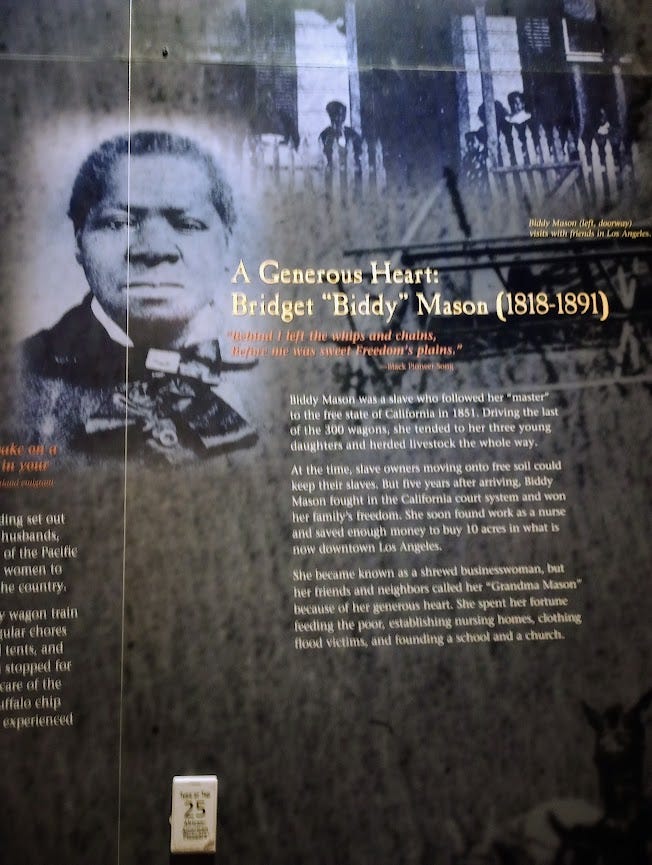
Beyond the Covered Wagons
And then, we headed upstairs, for Part 2. That’s when I realized this museum isn’t just about wagons: It’s about transportation going West, from that day to this. Now it was time to switch from covered wagons to stagecoaches, trains, and automobiles. Very cool!
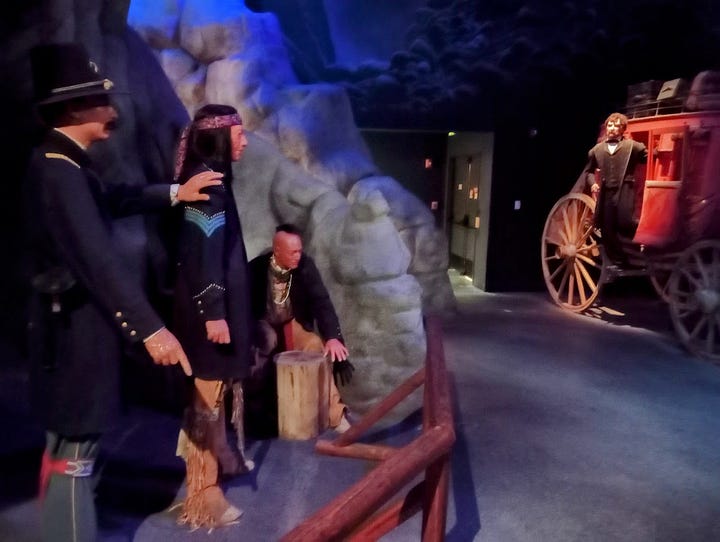
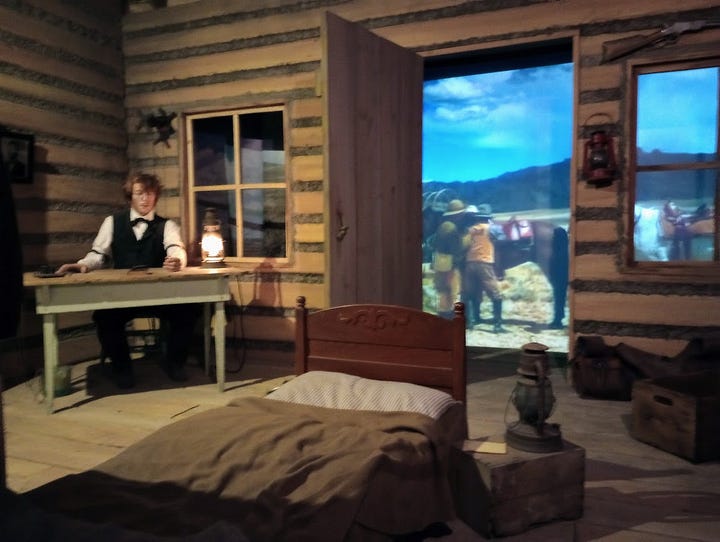


I hate that this photo essay is more photo than essay, but this museum is low on text and artifacts, and high on immersive displays, so I want to show you rather than tell you. Given where it is, in a place where most people are just passing through, then it makes sense.
First up, the Pony Express (see photo above). That form of communication didn’t last long, only 18 months starting in 1860, with blokes riding alone across the West. That’s very blokey history, all derring do, and I’ve never been all that interested. But the display at The Archway is very cool, and on the same lines as the buffalo display above, making good use of film to depict what’s happening outside. Plus the museum also covers telegraph lines and fibre optic cable, so the theme here is communications as well as transportation.
My favorite part of The Archway’s second floor is about the 20th century, when automobiles began traveling across the Platte, and it’s worth reminding kids that this how you all got to the museum. And that these kinds of journeys are not guaranteed to still happen in the future: They depend on laws, rules, infrastructure (roads and cell phone towers these days), and private cars.
First, we see a Model T, the first widely available affordable car for the masses, bumping along impossibly rutted roads. That's followed by the Lincoln Highways, the nation’s first long-distance paved nation road network, plus a recreation of one of early motor courts, providing cheap accommodation where you could easily unload your stuff right at the door of your room. This, of course, is the origin of the motel (UK think Crossroads, just kidding!) And yes, it probably was a bit grim. I think there’s an I Love Lucy episode about one of these places. Then again, I wonder if the sponsor of that episode of Lucy was a new corporate hotel chain, like Holiday Inn.
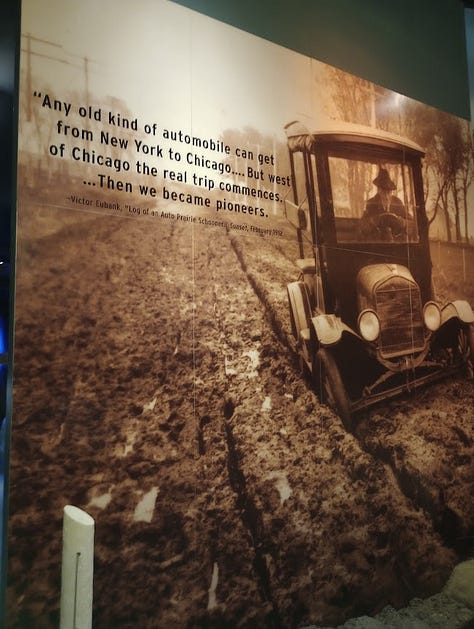
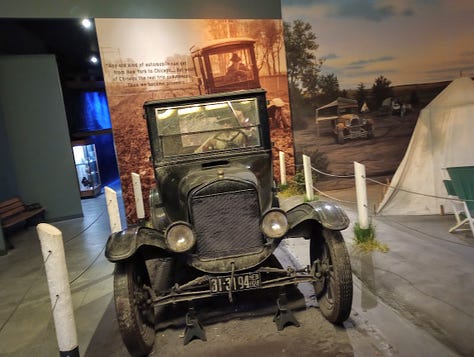
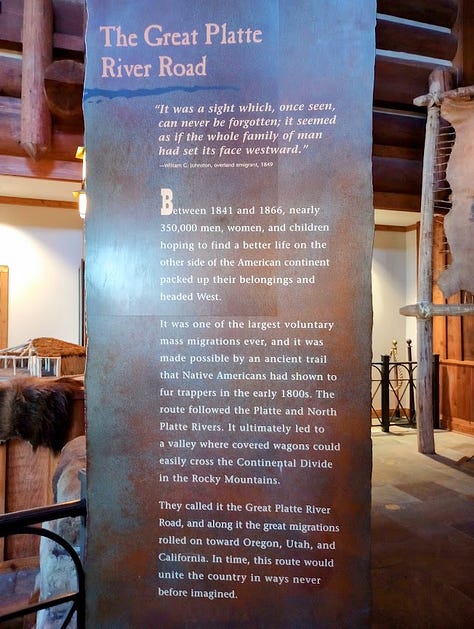


We reach a staged drive-through movie screen, and a display on people crossing the Platte by automobile, centered on a massive convertible (do I look like a car buff? I have no idea what it is) . This section represents the rise of the Eisenhower freeway system, of which the I-80 is a part. Gotta love the huge billboard photo of the happy white family waving from a convertible. Yeah, no motion sickness, “are we there yet?” or exhausted and angry parent threatening to come to the back seat and sort out the kids.
Meanwhile, Hoosen and I swear we saw something about Black travelers, who found it extremely hard to find accommodations, and who carried The Green Book, a guide to hotels, restaurants, and random church ladies who could help them, all around the country. Neither of us got a photo (which surprises me, honestly), so we do apologize. That’s quite unlike us, as regular readers know.
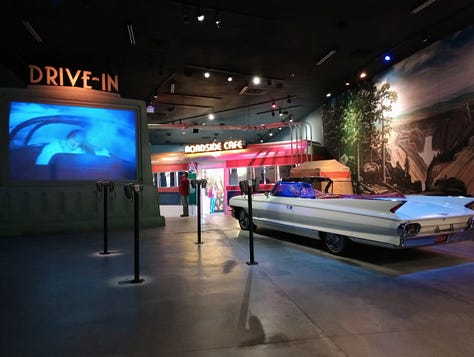


Last but not least, a mocked-up1950s style roadside diner is on display, with actual seating. Maybe they sell packaged snacks in summer? My favorite part of this room, though, was the radar detector. Kids as well as adults will enjoy looking out of the windows and checking out who is speeding
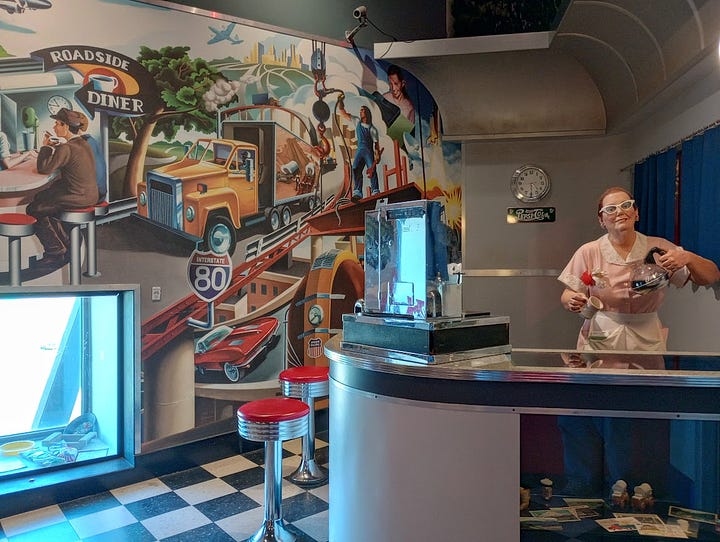

The Archway also includes ample clean loos, and a big gift shop that’s, sadly, low on historical stuff, and loaded with kitschy knick-knacks, but we can't have everything in life.
Don’t miss the Bonus section below for Nonnies, paying readers, on visiting this and other museums with kids.
Non-Boring History is the work of Annette Laing, PhD, Brit in America, and actual professional historian, also renegade on the run from her last university. All sorts of variety. Join us today as an annual or monthly member for all sorts of deliciousness for the ridiculously low cost of as little as $5 a month.

